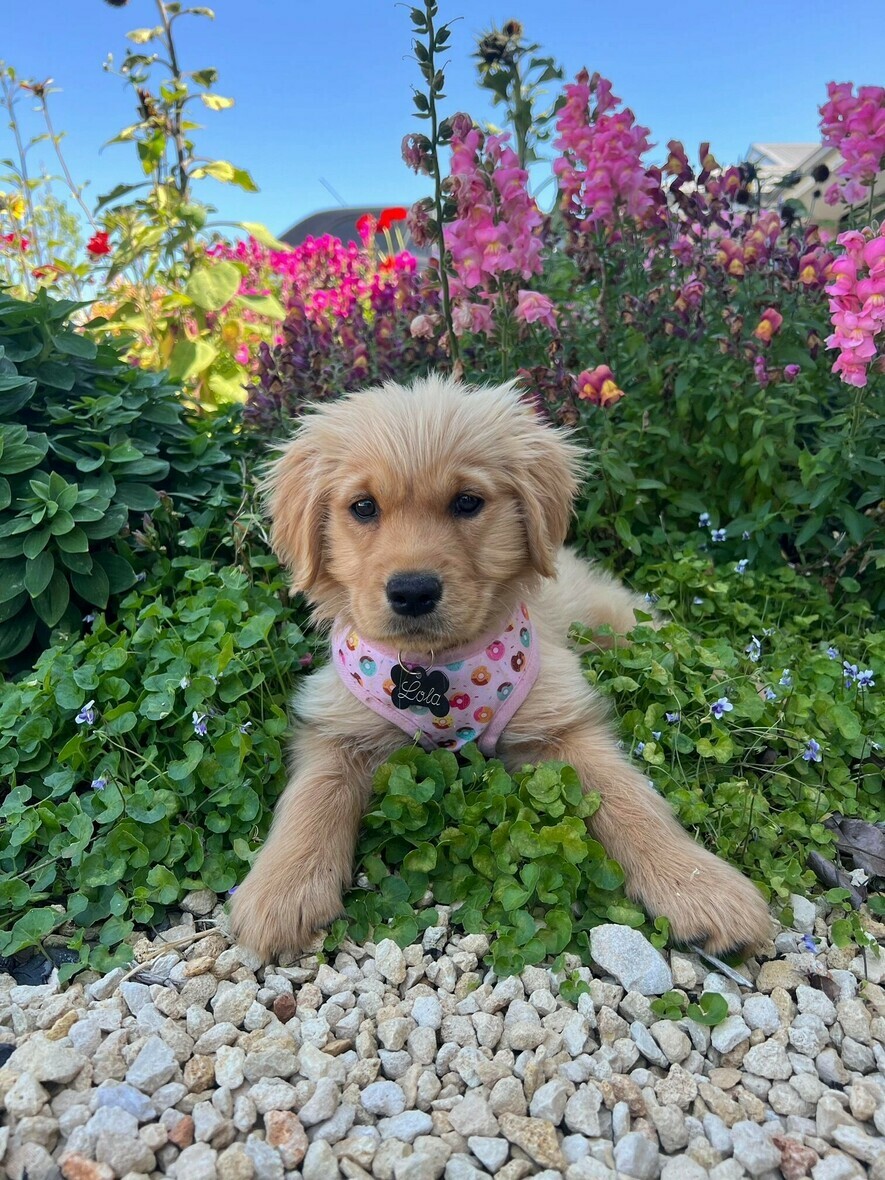
|
|
Lola’s Lucky Legs!
|
| |
Lola, a gorgeous 6-month old Golden Retriever, presented to the clinic with some unusual behaviour. She had started to bite at the air, an action termed “fly biting”. This can be both behavioural or related to pain or discomfort. It then progressed to her more specifically snapping at her hips regularly.
After some discussion of options it was deemed necessary to take some radiographs of her hips to check for signs of laxity or anything that could be causing discomfort before considering behavioural causes.
Lola was booked in for a procedure call “PennHip” radiographs. PennHip is a hip screening procedure developed by the University of Pensylvania. The radiographs are assessed and compared to a comprehensive medical database and indicate the individual animals risk of developing osteoarthritis from Canine Hip Dysplasia. The radiographs can be used as a screening tool in animals as young as 14 weeks to screen for risk and allow early intervention (Keep your eyes out for a story on Dr. Jaimie’s own pup Doug and his story!).
Dr Jenny performed Lola’s PennHIP radiographs and when we received the report it was found she has significant laxity in both hips- and was likely suffering already due to her conformation! Her pain was managed with oral medications and the fly biting resolved straight away!
Due to the extent of her issues the surgical specialist at SASH Kent Town was consulted. They advised that she was an excellent candidate for a specialist surgical procedure called a Double Pelvic Osteotomy for both of her hips. The goal of this surgery is to improve the fit of the head of the femur (ball) into the acetabulum (socket).
She had this procedure at SASH last month and hasn’t looked back since!
Her story highlights the importance of working up those funny and unusual clinical signs - we don’t always expect the things we find! It was well worth having those radiographs done so her owner could take the steps to markedly improve both her current and future quality of life! She can continue her active life of camping, beach outings and farm life well into the future!
|
|
|

|
|
Renting with pets: How to craft a winning pet resume
|
| |
Do you want to have a strong rental application while being open about your four-legged family members? Writing a pet resume can really help your landlord consider your pet a harmless plus rather than an inconvenience or risk.
Here’s our guide on how to apply with pets.
1. Ensure your pet is in peak canine/feline form
Your landlord is much more likely to think positively of your application if your pet is nicely groomed, free of parasites, and well-mannered.
For dogs and cats, this involves:
- Looking clean and well kept – ensure your pet’s fur looks and smells clean and has been recently trimmed if they are a breed whose fur constantly grows (e.g. a poodle or poodle mix)
- Having trimmed claws
- Not demonstrating any destructive or antisocial behaviours
- Being on an effective parasite control routine – ask our team for personalised advice on this if you’re unsure
Dogs who will be travelling through common areas of apartments should also be trained on how to walk calmly on lead.
If your pet has any destructive tendencies (such as scratching or chewing fixtures) or shows undesirable behaviours (such as persistent barking), it’s best to consult our team for help.
2. Write a professional-looking “pet resume” to include in your rental application
This should include:
- A picture of your pet looking gorgeous! Bonus points may ensue for boy dogs wearing bow ties
- A summary of your pet’s excellent training (e.g. obedience and toilet training for dogs and litter training for cats) and their (hopefully!) sociable nature
- A confirmation that they are regularly treated against parasites
- A statement that they are regularly exercised and kept busy to discourage any hyperactive or destructive behaviours
Landlords will also be reassured if you promise to have the property professionally cleaned at the end of your tenancy.
With the paw-fect application, you and your pet should be enjoying your new digs in no time! |
|
|
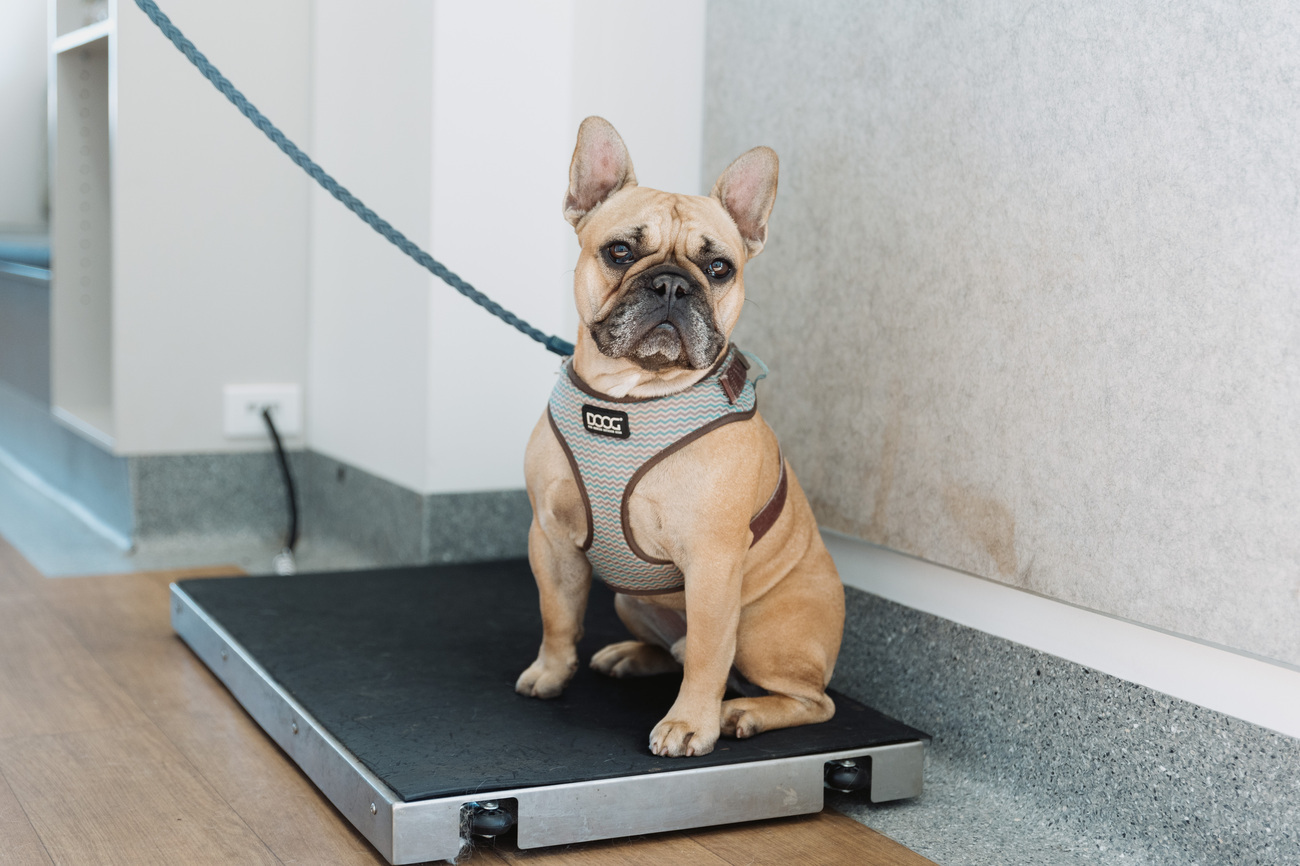
|
|
Squishy face maintenance
|
| |
If you have a brachycephalic pet such as a bulldog or pug, you’ll know that their cheery personalities come paw-in-hand with some extra care requirements!
One of the most important routines involves regular care for that cute little face. Welcome to Squishface Care 101.
1. Eye care
Because of their shallower eye sockets and shorter noses, the eyes of brachycephalic pets are more open and exposed, particularly in those individuals unable to fully close their eyes when sleeping. This means that brachycephalic pets are more prone to:
- Keratitis, which is drying and irritation of the cornea (the clear front surface of the eyeball)
- Eye ulcers (damage to the corneas), which can be serious
It’s best to gently wipe any eye discharge away 2-3 times daily with a clean tissue. For pets who can’t fully close their eyes, we also recommend pet-safe eye lubricating drops be applied several times daily.
If your pet’s eye ever looks unusually weepy or shows changes in colour or appearance, it’s best to bring them in for a prompt veterinary check.
2. Skin fold care
Brachycephalic pets usually have skin folds beneath their eyes and around their noses, which can easily become dirty and infected.
Wipe these folds out daily with hypoallergenic baby wipes, and then pat them dry and apply a thin layer of barrier cream. You can use a zinc-based cream such as Sudocrem, provided your pet (or any other pets) aren’t going to lick the area and ingest the cream.
If your pet’s skin fold ever looks red or oozy, it’s best to have them checked by our vets.
3. Dental care
With their smaller jaws, brachycephalic pets tend to have crowded teeth, making them prone to developing painful dental diseases.
We recommend veterinary dental checks for brachycephalic pets at least once per year, and a regular routine of dental hygiene maintenance at home.
For more personalised advice on caring for your snub-nosed friend, consult our snub-savvy team! |
|
|
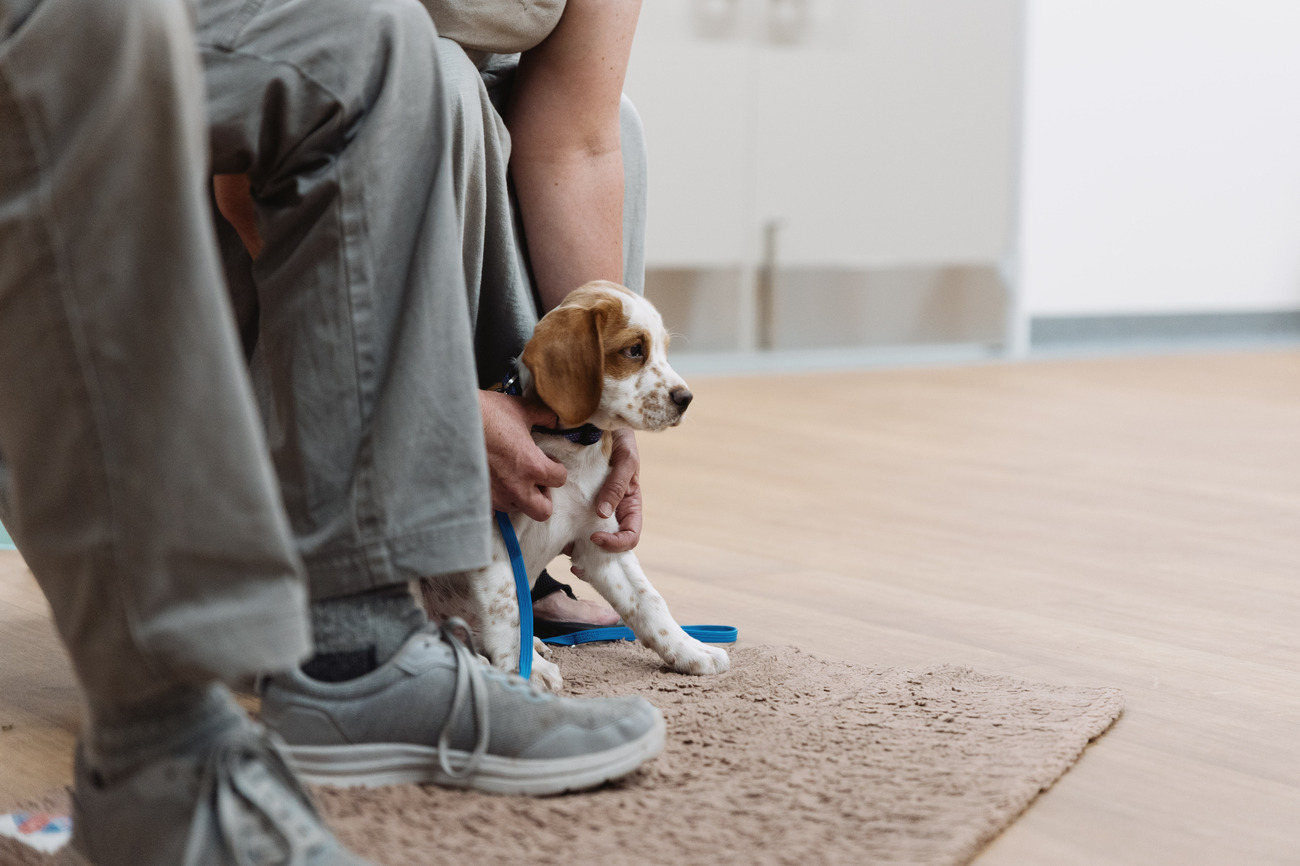
|
|
Puppy training essentials for good dog days
|
| |
Whilst puppies are certainly adorable, they’re also hard work! Here’s how to gently guide your new pup’s behaviour to set them up for lots of “good dog” days ahead!
Planning
Before you bring your pup home, have a discussion with any other family members to confirm the house rules. Will the pup be allowed on the furniture? Where will they toilet? Will pups be allowed to beg for table scraps or jump up for pats? Consistency is essential between all household members, or else your new pet will receive mixed messages.
It’s also sensible to puppy-proof your house in advance, ensuring pups have a comfortable, safe area they can be confined to when you can’t monitor them, where they don’t have access to chew anything dangerous (such as electrical cords). A solid baby pen, bathroom or laundry is normally suitable.
Early training
Positive reinforcement training is best for setting your pup up for good manners and calm confidence. This training involves keeping tasty treats on your person to immediately reward your pup for good behaviours, such as toileting in the right spot, sitting on command, or coming when called.
With toilet training often being one of the trickiest tasks, our top recommendation is to set up a regular schedule, where pups are taken to their toileting area after they eat, sleep, or have a play session. Puppies should otherwise be constantly monitored or put in their safe zone to prevent accidents around the house.
Socialisation
Socialisation involves gradually exposing your pup to a variety of people, environments, and other pets in a positive manner, so that they learn to be calm and confident in a range of situations. For maximum benefit, pups should receive good socialisation before 16 weeks old.
For tips on safe socialisation and training options for your pup prior to the completion of their puppy vaccinations, consult our helpful team. |
|
|
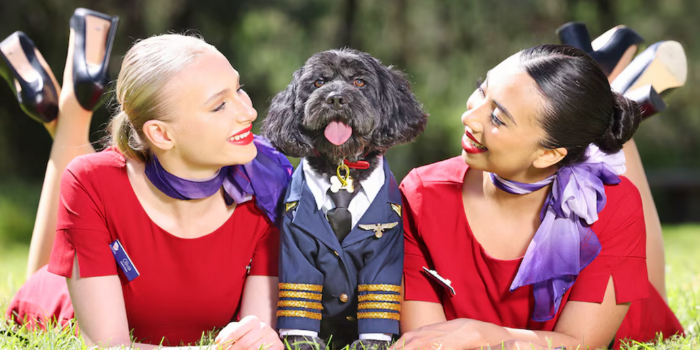
|
|
Animal News In Brief
|
| |
Virgin Australia welcomes pets in cabin
Virgin Australia is set to revolutionise pet travel by allowing small cats and dogs in the cabin for domestic flights, a first in the country. The service is expected to launch within the next 12 months, subject to regulatory approval. Virgin Australia group chief executive Jayne Hrdlicka emphasises this as a response to the strong desire among travellers to fly alongside their pets, stating, "Our love for animals has always been in the Virgin Australia DNA and we are excited at the prospect of taking off with Australia's first-ever pets in cabin flights." The service will require pet carriers to fit under the seat in front in designated rows to allow passengers who do not want to be near animals to book a seat away from them.
Click here to learn more about this plan from ABC News.
Photo credit: Virgin Australia
Why some kids fear dogs and how we can help
Cynophobia, the fear of dogs, affects about 5% of Australians, with children being particularly vulnerable. Psychologist Anthony Berrick from Sydney's Cynophobia Clinic observes that such fears often stem from negative experiences, which aren't limited to dog bites; even a lick from a dog can distress a child. He emphasises the importance of caregivers gradually introducing children to dogs, advocating for patience and understanding to foster a sense of control and security. Berrick suggests that when fears do not ease, seeking professional guidance can be beneficial, ensuring a methodical, supportive approach to help children overcome their phobia safely.
Click here to learn more about Cynophobia in children from ABC News.
The dog train: A joyful innovation for disabled dogs
Buket Özgünlü, leading the nonprofit Paws Holding on to Life Association in Turkey, cares for 560 stray dogs, many facing disabilities. “They were all rescued,” Özgünlü shares, revealing the dogs' tough backgrounds, from abandonment to injuries. Motivated by her father's disability, she prioritises disabled dogs, ensuring they have a chance at a new life. Özgünlü crafted a "dog train" from barrels, offering the dogs joyful rides around town, enriching their lives with new sights and sounds. “I was very happy that I did,” she remarks on the project, which has brought joy to the dogs.
Click here to read more about the dog train at The Dodo. |
|
|
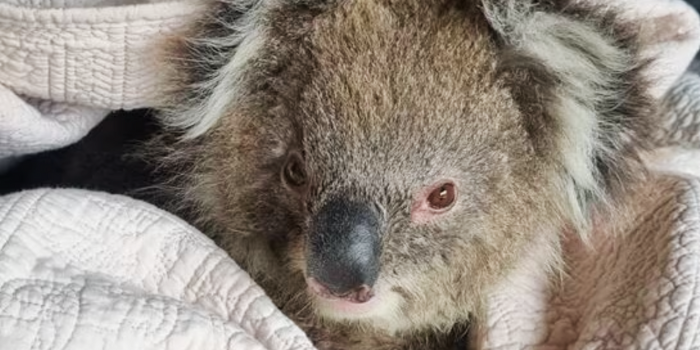
|
|
Urgent call to protect wildlife from summer fires
|
| |
Australia's bushfires are not just dangerous for homes but also for our unique animals. In the recent Victorian fires, wildlife rescuer Esther Hands shared the heartbreaking reality for koalas, with many unable to escape, leading to severe injuries and loss of habitat. "Now we fear they will be wiped out again, as all of their food source has been burnt," Hands expressed her deep concern for the koala population in the area.
Kevin Clapson, a sanctuary owner, recalls the 2019 bushfires' horrific impact, having to euthanise 50 kangaroos due to severe burns. "You can't colour it up, it is just horrible," Clapson remarked on the grim situation, highlighting the bushfire's ruthless annihilation of wildlife. The devastating effect of fires is evident as Clapson’s property saw the kangaroo population plummet from 100 to less than 15.
Conservation efforts are now more crucial than ever, with longer fire seasons and more intense fires threatening high conservation areas and the animals that inhabit them. Brendan Wintle, a conservation ecology professor, emphasises the urgency of mapping and protecting endangered species. "We have so many populations of threatened species... that are just hanging on," he stated, calling for more sophisticated plans to safeguard these vulnerable ecosystems.
Click here to read the ABC's full story.
Photo credit: Esther Hands |
|
|
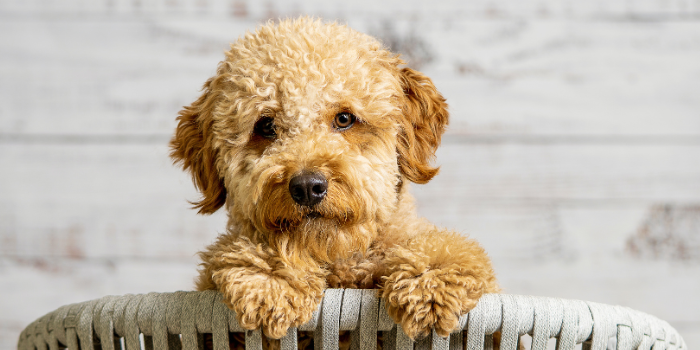
|
|
Essential tips for grooming your doodle
|
| |
If you’re thinking of getting a poodle cross dog (often commonly referred to as a doodle!), it’s a good idea to be aware of their special grooming and skin care requirements.
Here, we’ll answer some curly questions about doodle grooming.
1. How often should I groom my doodle?
Poodle cross dogs tend to have hair that grows constantly. This means they usually require a full groom (clip) every 6-8 weeks to keep them feeling comfortable. At this time, your doodle should also have its claws checked and trimmed if required.
In between grooms, it’s a good idea to brush your pet at least twice weekly to prevent matting, particularly focusing behind their ears, under their bellies, and at the back of their legs.
2. When should I get my doodle pup groomed for the first time?
Doodle pups usually have a “puppy coat”, which is softer and fluffier than adult doodle hair.
Puppies generally require their first groom by 5-6 months old. However, they should also receive a few partial clips before this to shorten the hair around their face (so it doesn’t grow over their eyes) and paws.
3. Do I need to pluck my doodle’s ears?
Plucking ear canal fur is uncomfortable and can cause irritation of the skin. Therefore, we recommend only plucking your doodle’s ears if the fur tends to become very thick and matted with wax, or if they suffer from recurrent ear problems.
4. What other special care might my doodle need?
As well as routine grooming, your doodle might require:
- Emptying of their anal glands – anal glands in dogs usually empty during defecation, but smaller breeds tend to be predisposed to blockage of their anal glands, which can result in painful infection
- Monitoring for hot spots – these are localised areas of oozy skin inflammation, which are highly irritated and usually require veterinary treatment
For more information on doodle care, consult our poodle-proficient team! |
|
|
This email contains comments of a general nature only and is not intended to be a substitute for professional veterinary advice. It should not be relied on as the basis for whether you do or don't do anything.
All content © PetPack 2023 |
|
|
[Footer]
|